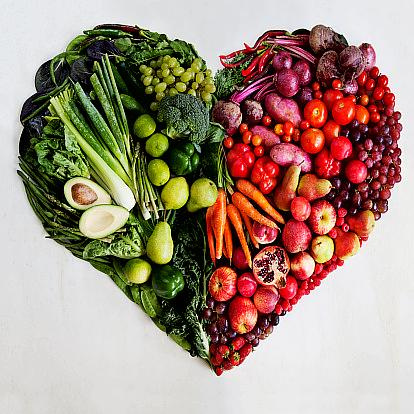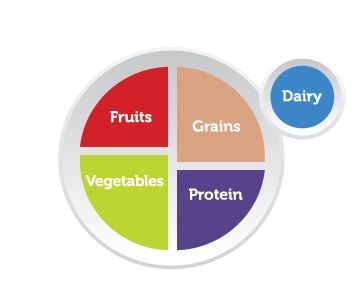
Helping Kids Eat Right
Your individual nutrition and calorie needs depend on your age, gender, level of physical activity and other health factors, but according to MyPlate, a website from the Center for Nutrition Policy and Promotion, an agency of U.S. Department of Agriculture, a balanced and healthy diet should include:
- Fruits and vegetables. Combined, these should cover half your plate at meals.
- Grains. At least half of the grains you eat should be whole grains, such as oatmeal, whole wheat bread and brown rice.
- Dairy. Choose low-fat or fat-free dairy foods most often.
- Protein. Make lean protein choices, such as lean beef, skinless poultry and fish. Vary your protein choices to also include eggs, beans, peas and legumes. Eat at least eight ounces of seafood a week.
 When kids follow the MyPlate recommendations for daily servings, they are well on their way to healthy eating and a healthy weight. Unfortunately, many kids today seem to be suffering from “portion distortion.” When talking about what kids eat or drink, keep these definitions in mind.
When kids follow the MyPlate recommendations for daily servings, they are well on their way to healthy eating and a healthy weight. Unfortunately, many kids today seem to be suffering from “portion distortion.” When talking about what kids eat or drink, keep these definitions in mind.
Serving Size
A serving is a specific amount of food or drink that is defined by common measurements, such as cups, ounces or tablespoons. Examples include recommended servings from MyPlate (the amount kids should eat) and the serving size on a Nutrition Facts label, which is the basis for all the other nutrition information on the label. In many cases, the serving size listed on the Nutrition Facts label is different from the MyPlate recommended serving size. In fact, many of the MyPlate serving sizes are smaller than those listed on the Nutrition Facts Label.
Portion Size
A portion is basically the amount of food that happens to end up on the plate. Think of portion size as the actual amount of food kids choose to eat at breakfast, lunch, dinner or as a snack. Portions can be bigger or smaller than the recommended serving size.
Visualizing Appropriate Portion Sizes
One reason kids may not be eating appropriately sized portions based on the recommended MyPlate serving sizes is that they may not recognize what a reasonable portion looks like. What does one-half cup of pasta look like? What about three ounces of chicken or two tablespoons of peanut butter?
The good news is that kids don’t need a measuring cup or scale to measure the portions they should eat – instead, they can visualize them by seeing familiar objects, such as a tennis ball or CD, that are similar in size to recommended serving sizes. Before they eat or drink, they can think of the relevant object and choose a portion that matches its size. 1
Here are some tips to help you and your kids visualize portion sizes:
| Food | Portion Size | About the Size of… | ||
| Grains Group | ||||
| Bread | 1 ounce or 1 regular slice | CD cover | ||
| Dry cereal | 1 ounce or 1 cup | Baseball | ||
| Cooked cereal, rice or pasta | 1 ounce or ½ cup | ½ baseball | ||
| Pancake or waffle | 1 ounce or 1 small piece (6 inches) | CD | ||
| Bagel, hamburger bun | 1 ounce or ½ piece | Hockey puck | ||
| Cornbread | 1 piece | Bar of soap |
| Fruits Group | ||||
| Orange, apple, pear | 1 small fruit (2½ inches in diameter) | Tennis ball | ||
| Raisins | ¼ cup | Golf ball |
| Vegetables Group | ||||
| Baked potato | 1 medium | Computer mouse | ||
| Vegetables, chopped or salad | 1 cup | Baseball |
| Dairy Group | ||||
| Fat-free or low-fat milk or yogurt | 1 cup | Baseball | ||
| Cheese | 1½ ounces natural cheese or 2 ounces processed cheese | 9-volt battery | ||
| Ice cream | ½ cup | ½ baseball |
| Protein Foods Group | ||||
| Lean beef or poultry | 3 ounces | Deck of cards | ||
| Grilled or baked fish | 3 ounces | Checkbook | ||
| Peanut butter | 2 tablespoons | Ping-pong ball |
| Oils Group | ||||
| Margarine | 1 teaspoon | Standard postage stamp | ||
| Oil or salad dressing | 1 teaspoon | Standard cap on a 16-ounce water bottle |
Dental Health and Drinks
For many children and teens, grabbing a soft drink, juice drink or energy drink seems like a quick fix. However, these drinks contain a variety of ingredients that can be damaging to your child’s health. According to a list of sugar in soft drinks from The University of Cincinnati, Clermont College, some popular soda drinks have over 40 grams of sugar per serving. Consumption of this much sugar can result in undesirable health effects, and parents should encourage alternatives to sugar-laden sodas for their children.
Consuming soft drinks can have a negative effect on your child’s dental health too. The American Dental Association explains that excess sugar intake, especially in sugared soft drinks, can damage the enamel on teeth. Bacteria feed off of sugar and form plaque on teeth. This can eventually lead to excess plaque buildup and cavities. If your child doesn’t brush his teeth after a sugary drink, cavities can form, leading to tooth decay and gum disease.2
1 http://www.mouthhealthy.org/en/nutrition/food-tips?source=facebook&content=nnm_what_you_eat_affects_teeth
2 http://www.livestrong.com/article/266028-the-effect-of-soft-drinks-on-children/
